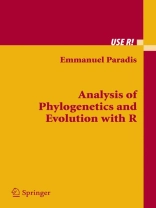As a result, the inference of phylogenies often seems divorced from any connection to other methods of analysis of scienti?c data. Felsenstein Once calculation became easy, the statistician’s energies could be – voted to understanding his or her dataset. Venables & Ripley The study of the evolution of life on Earth stands as one of the most complex ?elds in science. It involves observations from very di?erent sources, and has implications far beyond the domain of basic science. It is concerned with processes occurring on very long time spans, and we now know that it is also important for our daily lives as shown by the rapid evolution of many pathogens. As a ?eld ecologist, for a long time I was remotely interested in phylo- netics and other approaches to evolution. Most of the work I accomplished during my doctoral studies involved ?eld studies of small mammals and es- mation of demographic parameters. Things changed in 1996 when my interest was attracted by the question of the e?ect of demographic parameters on bird diversi?cation. This was a new issue for me, so I searched for relevant data analysis methods, but I failed to ?nd exactly what I needed. I started to conduct my own research on this problem to propose some, at least partial, solutions. This work made me realize that this kind of research critically – pends on the available software, and it was clear to me that what was o?ered to phylogeneticists at this time was inappropriate.
Daftar Isi
First Steps in R for Phylogeneticists.- Phylogenetic Data in R.- Plotting Phylogenies.- Phylogeny Estimation.- Analysis of Macroevolution with Phylogenies.- Developing and Implementing Phylogenetic Methods in R.












